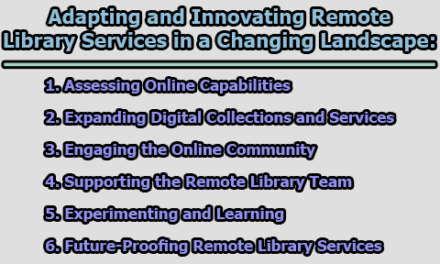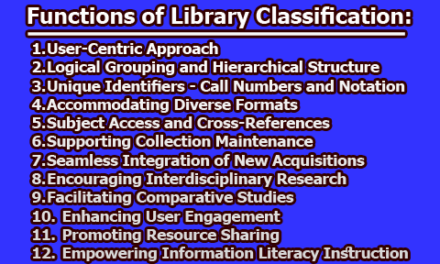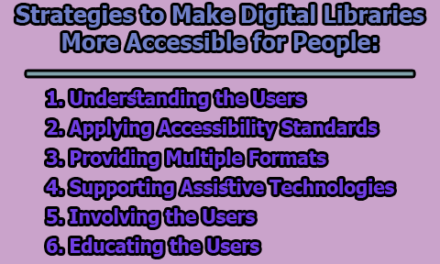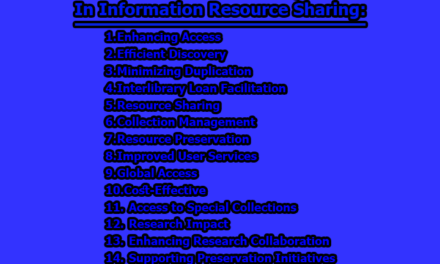Library Automation and Digitalization:
Library automation refers to the use of computer systems and software to streamline library operations, such as cataloging, circulation, and inventory management. Digitalization, on the other hand, involves the conversion of analog resources (e.g., books, manuscripts, photographs) into digital formats, making them accessible through electronic devices and the internet. These two processes, when integrated effectively, have the potential to reshape the way libraries function, making them more efficient and accessible in the digital age. This article explores the concepts of library automation and digitalization, examining their historical evolution, benefits, challenges, and future prospects. By delving into these aspects, we can gain a deeper understanding of how libraries are adapting to the digital age and their role in an increasingly interconnected world.
1. Historical Evolution of Library Automation:
The journey towards library automation can be traced back to the mid-20th century, with the advent of computers and the recognition of their potential to enhance library operations. Several key milestones mark the historical evolution of library automation:
1.1. Early Attempts (1950s-1960s): The early efforts in library automation involved the use of punch cards and batch processing to catalog and manage library collections. One of the pioneering systems during this era was the MARC (Machine-Readable Cataloging) format, developed by the Library of Congress in the 1960s. MARC revolutionized cataloging by creating a standardized format for bibliographic records that could be processed by computers.
1.2. The Rise of Integrated Library Systems (1970s-1980s): The 1970s and 1980s witnessed the emergence of Integrated Library Systems (ILS) or Library Management Systems (LMS). These systems integrated various library functions, including cataloging, circulation, and acquisitions, into a single software platform. ILS allowed libraries to manage their collections more efficiently and provide better services to patrons.
1.3. The Internet and Web-Based Systems (1990s-Present): The proliferation of the internet in the 1990s brought about a significant shift in library automation. Web-based systems and online catalogs (OPACs – Online Public Access Catalogs) replaced the traditional card catalog. Libraries started offering digital resources and services, including e-books, e-journals, and online databases. The emergence of the World Wide Web made it possible for patrons to access library resources remotely.
1.4. Open Source and Interoperability (2000s-Present): In recent years, open-source library automation systems like Koha and Evergreen have gained popularity. These systems offer cost-effective alternatives to proprietary software and promote collaboration among libraries. Interoperability has also become a key focus, enabling libraries to share resources and services more easily.
2. Digitalization of Library Collections:
The digitalization of library collections represents a pivotal shift in how libraries manage and provide access to their resources. It involves the conversion of physical materials, such as books, manuscripts, photographs, and other analog resources, into digital formats. This process allows libraries to preserve, share, and make these materials accessible through electronic devices and the Internet. Here, we explore the various aspects of the digitalization of library collections.
2.1 Scanning and Digitization: At the core of the digitalization process is scanning and digitization. This step involves converting physical materials into digital files. Key considerations during this phase include:
- Equipment and Technology: High-quality scanners, cameras, and specialized digitization equipment are used to capture images and text from physical items. The choice of equipment depends on the type and condition of the material being digitized.
- Image Resolution: The resolution of digitized images is critical to capture fine details. Different types of materials may require different resolutions for optimal digitization quality.
- Preservation: Handling and preservation of the original material is of utmost importance. Archival-grade scanning techniques ensure that the physical item is not damaged during the digitization process.
- Metadata Creation: Concurrently, metadata is created or enhanced. Metadata includes information such as titles, authors, publication dates, descriptions, and copyright information. Well-structured metadata is crucial for the organization and discoverability of digital collections.
2.2 Preservation and Long-Term Access: Once materials are digitized, preserving digital assets becomes a critical concern. Digital materials can be fragile and are subject to format obsolescence, data corruption, and technological changes. Preservation strategies include:
- File Formats: Choosing open and sustainable file formats ensures long-term access to digital materials. Formats like PDF/A for text and TIFF for images are commonly used for preservation.
- Backup and Redundancy: Implementing robust backup and redundancy systems prevents data loss due to hardware failure or other unforeseen events.
- Migration and Emulation: Libraries employ strategies like format migration and emulation to adapt digital files to evolving technologies while retaining their authenticity.
- Digital Repositories: Establishing digital repositories with specialized preservation tools and services helps libraries manage and safeguard digital collections effectively.
2.3 Access and User Interfaces: Making digitized materials accessible to users is a primary goal of the digitalization process. This involves the creation of user-friendly interfaces and platforms:
- Digital Libraries: Libraries often create dedicated digital libraries or collections where users can search, browse, and access digitized materials. These platforms provide a structured environment for organizing digital resources.
- Search and Discovery: Advanced search functionalities enable users to find materials efficiently. Features like keyword searching, faceted browsing, and relevance ranking enhance the user experience.
- Full-Text Searching: Many digitized collections incorporate optical character recognition (OCR) technology to make the text within images searchable. This feature is particularly useful for books, newspapers, and other textual materials.
- User Engagement: Libraries aim to engage users by providing interactive features such as zoomable images, annotations, and collaborative tools for research and study.
2.4 Copyright and Licensing: Navigating copyright and licensing issues is a significant consideration in the digitalization of library collections:
- Public Domain Materials: Materials in the public domain (not protected by copyright) are often the first candidates for digitization, as they can be freely shared and accessed.
- Copyright Clearance: For copyrighted materials, libraries must obtain the necessary permissions and licenses to digitize and distribute them. This may involve negotiations with rights holders or adherence to fair use and copyright exceptions.
- Creative Commons: Some libraries choose to release digitized materials under Creative Commons licenses, allowing users to use, share, and build upon the content within specified terms.
2.5 Access for Diverse Users: The digitalization of library collections also focuses on providing access to diverse user groups:
- Accessibility: Libraries make efforts to ensure that digital collections are accessible to individuals with disabilities. This includes providing text-to-speech functionality, screen readers, and alternative formats for visually impaired users.
- Multilingual Access: Digitized materials may be offered in multiple languages to cater to a global and diverse audience.
- Mobile-Friendly Access: Libraries optimize their digital platforms for mobile devices to accommodate users who access collections on smartphones and tablets.
3. Benefits of Library Automation and Digitalization:
Library automation and digitalization offer a multitude of benefits for libraries, patrons, and society as a whole. These advancements have transformed the way libraries function, making information more accessible, efficient, and adaptable to the digital age. Here, we provide most of the necessary advantages of library automation and digitalization.
3.1 Enhanced Access to Resources: One of the most significant benefits of library automation and digitalization is the improvement in access to resources:
- Remote Access: Digital catalogs and online databases allow patrons to access library resources from anywhere with an internet connection. This eliminates geographical barriers and provides users with 24/7 access to the library’s collections.
- Global Reach: Libraries can extend their reach beyond their physical locations. Users from around the world can search, browse, and access digital resources, fostering a global community of learners and researchers.
- Expanded Collections: Libraries can offer a more extensive and diverse collection of materials, including e-books, e-journals, digitized manuscripts, photographs, and multimedia resources. This expansion caters to a broader range of user interests and needs.
3.2 Improved Search and Discovery: Library automation and digitalization have revolutionized how users search for and discover materials:
- Advanced Search Functionalities: Digital catalogs and databases provide users with powerful search tools, including keyword searching, Boolean operators, and faceted browsing. These features enable users to find materials more efficiently and precisely.
- Relevance Ranking: Automated systems use algorithms to rank search results based on relevance, ensuring that users see the most pertinent materials first. This enhances the user experience and saves time.
- Full-Text Searching: Optical character recognition (OCR) technology allows users to search within the full text of digital resources, making it easier to locate specific information within documents and books.
3.3 Preservation of Cultural Heritage: Library automation and digitalization contribute significantly to the preservation of cultural heritage:
- Preservation of Rare and Fragile Materials: Libraries can digitize and preserve rare, fragile, or deteriorating materials, ensuring their long-term survival. This is particularly crucial for historical manuscripts, photographs, and artworks.
- Cultural Heritage Preservation: Digitalization efforts help preserve a nation’s cultural heritage by making historical documents, artworks, and artifacts accessible to future generations.
- Reducing Physical Handling: Digital copies reduce the need to handle physical materials, minimizing wear and tear on valuable items.
3.4 Space Efficiency: Digitalization helps libraries optimize their physical space:
- Reduced Storage Needs: Digitized materials take up significantly less physical space compared to their analog counterparts, allowing libraries to allocate space for other purposes such as study areas, collaborative workspaces, and technology centers.
- Preservation of Physical Space: Libraries can preserve historic or architecturally significant spaces by reducing the need for extensive storage of physical materials.
- Environmental Impact: By reducing the need for physical storage, libraries contribute to environmental sustainability by consuming fewer resources and reducing their carbon footprint.
3.5 Cost Savings: Library automation and digitalization can lead to cost savings for libraries:
- Reduced Acquisition Costs: Libraries can acquire digital resources at a lower cost than physical materials. E-books, for example, often cost less than printed books, and digital subscriptions eliminate the expenses associated with print journals.
- Operational Efficiency: Automated systems streamline library operations, including cataloging, circulation, and inventory management. This increased efficiency can result in reduced labor costs.
- Preservation Costs: While digitization requires an initial investment, maintaining digital materials is often more cost-effective than preserving physical items, which may require conservation efforts.
3.6 Accessibility: Library automation and digitalization contribute to increased accessibility for all patrons:
- Accessibility for Individuals with Disabilities: Libraries can make digital resources more accessible to individuals with disabilities by offering features like text-to-speech technology, screen readers, and customizable formats.
- Multilingual Access: Digital collections can be made available in multiple languages, broadening their appeal to diverse user groups.
- User-Centered Design: Libraries prioritize user-centered design in their digital interfaces, ensuring that they are intuitive and user-friendly for a wide range of patrons.
3.7 Interlibrary Cooperation and Resource Sharing: Library automation systems facilitate interlibrary cooperation and resource sharing:
- Resource Sharing: Libraries can easily share digital resources, reducing duplication of efforts and expanding the range of materials available to their patrons.
- Consortiums and Collaborations: Libraries can participate in consortia and collaborative initiatives that allow them to pool resources and share digital collections, further benefiting their users.
- Increased Availability: Users gain access to a broader range of materials from multiple libraries, increasing the likelihood of finding relevant resources.
3.8 Data-Driven Decision Making: Library automation systems provide valuable data and analytics that enable informed decision-making:
- Collection Development: Usage data helps libraries make informed decisions about collection development, allowing them to tailor their collections to the preferences and needs of their patrons.
- Resource Allocation: Data on resource usage and patron behavior can inform decisions about resource allocation, staffing, and budgeting.
- User Engagement: Analytics can reveal insights into user engagement with digital resources, helping libraries enhance their services and user experience.
3.9 Adapting to Changing Needs: Library automation and digitalization make libraries more adaptable to evolving user needs:
- Rapid Updates: Digital collections can be updated and expanded more quickly than physical collections, allowing libraries to stay current with changing trends and topics.
- Flexibility: Libraries can tailor their digital collections to serve specific user groups or emerging research areas, ensuring relevance and usability.
- Integration with Emerging Technologies: Libraries can seamlessly integrate new technologies such as artificial intelligence, virtual reality, and augmented reality to enhance user experiences and services.
4. Challenges and Considerations:
Library automation and digitalization bring numerous benefits, but they also present challenges and considerations that libraries must address. These challenges span technical, ethical, financial, and operational aspects of library management. Here, we provide some of the key challenges and considerations associated with library automation and digitalization.
4.1 Financial Considerations:
- Initial Investment: Implementing library automation and digitalization systems requires a significant upfront investment in hardware, software, training, and infrastructure. Libraries must secure funding for these expenses, which can be a substantial barrier for smaller institutions.
- Ongoing Costs: Beyond the initial investment, libraries face ongoing costs for system maintenance, upgrades, technical support, and content licensing fees for digital resources. Ensuring a sustainable financial model is crucial.
- Return on Investment (ROI): Libraries need to demonstrate the ROI of their digitalization efforts to justify continued funding. Measuring ROI can be challenging, as it may involve assessing factors like increased access, user satisfaction, and operational efficiencies.
4.2 Copyright and Licensing:
- Copyright Compliance: Libraries must navigate complex copyright laws and licensing agreements when digitizing and providing access to materials. This involves determining copyright status, securing permissions, and complying with fair use and other exceptions.
- Licensing Costs: Licensing digital resources, especially scholarly journals and databases, can be expensive. Libraries must negotiate favorable terms and consider the long-term sustainability of these agreements.
- Licensing Restrictions: Licensing agreements often come with restrictions on how digital materials can be used, shared, and preserved. Libraries must carefully manage these restrictions while ensuring access to users.
4.3 Privacy and Data Security:
- Patron Privacy: As libraries collect and analyze user data to improve services, they must balance the benefits of personalization with the need to protect patron privacy. Implementing strong data protection measures is essential.
- Data Breaches: Libraries must safeguard digital collections and user data against security breaches, hacking attempts, and data loss. Developing and implementing robust cybersecurity protocols is critical.
4.4 Digital Preservation:
- Format Obsolescence: Digital materials are vulnerable to format obsolescence, meaning that file formats and technologies used for digitization may become outdated. Libraries must develop strategies for format migration and emulation to ensure long-term access.
- Sustainability: Ensuring the long-term sustainability of digital collections requires ongoing investment in preservation activities, including refreshing storage media, updating metadata, and monitoring content integrity.
4.5 Quality Control:
- Accuracy and Authenticity: Libraries must maintain the accuracy and authenticity of digitized materials. This involves quality control checks to ensure that digital copies faithfully represent the original items.
- Metadata Quality: High-quality metadata is crucial for the discoverability and usability of digital collections. Inaccurate or incomplete metadata can hinder users’ ability to find and use resources effectively.
4.6 Ethical Considerations:
- Cultural Sensitivity: Libraries must approach the digitization of culturally sensitive materials with care and respect for indigenous knowledge and heritage. Consultation with affected communities and adherence to ethical guidelines is essential.
- Handling Sensitive Materials: Libraries may encounter materials that contain sensitive or controversial content. Developing policies and procedures for handling such materials, including user access restrictions, is necessary.
- Long-Term Access to Born-Digital Content: Ensuring the preservation and accessibility of born-digital materials, such as websites, social media content, and electronic records, presents unique ethical and technical challenges.
4.7 Digital Divide:
- Unequal Access: The digital divide refers to the gap in access to digital resources and technology. Libraries must consider how to bridge this gap and ensure equitable access to their digital collections, especially for underserved communities.
- Digital Literacy: Even when digital resources are accessible, not all users possess the necessary digital literacy skills to navigate digital libraries effectively. Libraries may need to provide training and support to bridge this knowledge gap.
4.8 Technological Challenges:
- Technological Obsolescence: Technology evolves rapidly, and libraries must continually update and adapt their automation and digitalization systems to remain compatible with new software, hardware, and standards.
- Interoperability: Integrating various library systems and ensuring their compatibility with each other can be complex. Achieving seamless interoperability between different technologies is an ongoing challenge.
4.9 Training and Skill Development:
- Staff Training: Library staff require training and professional development to effectively operate and maintain automation and digitalization systems. Keeping staff up-to-date with evolving technologies is an ongoing commitment.
- Skill Diversification: With the integration of new technologies like artificial intelligence and virtual reality, libraries need to diversify their skill sets, which can be challenging for staff with traditional library backgrounds.
4.10 User-Centered Design:
- Usability: Creating user-friendly interfaces and platforms that cater to diverse user needs and abilities is a continuous effort. Libraries must conduct usability testing and gather user feedback to improve the user experience.
- Accessibility: Libraries must ensure that digital interfaces are accessible to individuals with disabilities. Adhering to accessibility standards and guidelines is critical to serving all users effectively.
5. Future Prospects and Trends:
The future of libraries in the context of library automation and digitalization is marked by ongoing technological advancements, changing user expectations, and evolving societal needs. Libraries are continuously adapting to remain relevant and provide valuable services in an increasingly digital world. Here, we examine key future prospects and trends in library automation and digitalization.
5.1 Artificial Intelligence (AI) and Machine Learning:
- Enhanced Search and Discovery: AI and machine learning technologies will be integrated into library automation systems to improve search and recommendation functionalities. These technologies can analyze user behavior, preferences, and historical search patterns to provide more personalized and relevant content recommendations.
- Chatbots and Virtual Assistants: Libraries will employ chatbots and virtual assistants powered by AI to provide instant, automated responses to user inquiries, enhancing user support and engagement.
- Predictive Analytics: Libraries will utilize predictive analytics to anticipate user needs, optimize resource allocation, and make data-driven decisions about collection development and service improvements.
5.2 Expanded Digital Collections:
- Diverse Digital Resources: Libraries will continue to expand their digital collections, offering a wider range of materials, including e-books, e-journals, digitized manuscripts, multimedia resources, and open-access materials.
- Streaming and Interactive Content: Libraries will incorporate streaming services, interactive media, and virtual reality experiences into their digital collections to cater to diverse learning and research needs.
5.3 Virtual Reality (VR) and Augmented Reality (AR):
- Immersive Learning Environments: Libraries will leverage VR and AR technologies to create immersive learning environments, offering virtual tours, interactive exhibits, and enhanced research experiences.
- Enhanced Education and Training: VR and AR can be used for educational and training purposes, allowing users to engage with historical simulations, scientific models, and interactive tutorials.
5.4 Open Access Initiatives:
- Promotion of Open Access: Libraries will continue to champion open access initiatives, advocating for open-access publishing and repositories to facilitate the free dissemination of research outputs and educational materials.
- Institutional Repositories: Libraries will expand their institutional repositories to host and preserve a wider range of research outputs, including datasets, preprints, and multimedia content.
5.5 Data Curation and Management:
- Research Data Services: Libraries will offer comprehensive data curation and management services, assisting researchers and institutions in organizing, preserving, and sharing their research data effectively.
- Data Visualization: Libraries will support data visualization tools and services, helping researchers communicate their findings through compelling visual representations.
5.6 Sustainable Practices:
- Environmental Sustainability: Libraries will adopt sustainable practices in digitization, resource management, and building design to reduce their carbon footprint and promote environmental responsibility.
- Green Libraries: Libraries will explore sustainable building design, energy-efficient technologies, and eco-friendly materials in their physical spaces to serve as models of environmental stewardship.
5.7 Community Engagement:
- Multifunctional Spaces: Libraries will continue to evolve as multifunctional community hubs, offering a wide range of services beyond traditional book lending. These services may include maker spaces, community programs, collaborative workspaces, and civic engagement initiatives.
- Outreach and Partnerships: Libraries will engage in community outreach and partnerships with local organizations, schools, and businesses to address community needs and foster collaboration.
5.8 Accessibility and Inclusivity:
- Universal Design: Libraries will prioritize universal design principles, ensuring that digital interfaces, physical spaces, and services are accessible and inclusive to individuals of all abilities and backgrounds.
- Assistive Technologies: Libraries will invest in assistive technologies to make digital resources and services accessible to individuals with disabilities, ensuring that no one is left behind.
5.9 Preservation of Born-Digital Content:
- Web Archiving: Libraries will focus on preserving born-digital content, including websites, social media, and electronic records, to capture and document the digital cultural heritage of their communities.
- Digital Stewardship: Libraries will assume a role as digital stewards, ensuring the long-term preservation and accessibility of digital materials, even as technologies evolve.
5.10 Civic Engagement and Social Responsibility:
- Information Literacy: Libraries will continue to play a vital role in fostering information literacy skills, helping users critically evaluate and navigate digital information sources.
- Digital Equity: Libraries will advocate for digital equity, striving to bridge the digital divide by providing access to technology, training, and digital resources for underserved and marginalized communities.
- Social Responsibility: Libraries will uphold their role as bastions of intellectual freedom, safeguarding democratic principles, and ensuring equitable access to information, regardless of political or social pressures.
In conclusion, Library automation and digitalization have ushered libraries into the digital age, enhancing their ability to serve as hubs of knowledge and culture. The integration of technology has made library resources more accessible, efficient, and adaptable to the changing needs of patrons. While challenges exist, libraries are poised to embrace emerging technologies and trends, ensuring their continued relevance in an interconnected world. As libraries continue to evolve, they remain vital institutions in fostering lifelong learning, preserving cultural heritage, and promoting equitable access to information. The future of libraries will be shaped by their ability to harness the power of automation, digitalization, and emerging technologies while staying true to their mission of serving diverse communities and advancing knowledge.
References:
- Kroski, E. (2019). Library Technology and Digital Resources: An Introduction for Support Staff. Libraries Unlimited.
- Rubin, R. E. (2010). Foundations of Library and Information Science. Neal-Schuman Publishers.
- Matthews, J. R. (2014). Library Automation in the United States: A Retrospective View into the 21st Century. Advances in Library Administration and Organization, 32, 1-54.
- Lancaster, F. W. (2015). Toward paperless information systems. Information Processing & Management, 51(4), 393-413.
- Manzoor, A., & Khurshid, S. (2013). Challenges and opportunities of digital libraries in current era. Library Philosophy and Practice, 2013.
- Borgman, C. L. (2015). Big Data, Little Data, No Data: Scholarship in the Networked World. MIT Press.
- Dempsey, L. (2008). Always On: Libraries in a World of Permanent Connectivity. First Monday, 13(2).
- Borgman, C. L. (2015). Big Data, Little Data, No Data: Scholarship in the Networked World. MIT Press.
- Chowdhury, G. (2003). Introduction to Digital Libraries. Facet Publishing.
- Singh, D., & Malhotra, H. (2008). Digital Libraries: Challenges and Opportunities. The International Information & Library Review, 40(2), 120-130.
- Lankes, R. D. (2011). The Atlas of New Librarianship. MIT Press.
- Arms, W. Y., & Larsen, R. (2007). Digital Libraries. MIT Press.
- Murray, P., & Madoff, R. (2019). Digital Library Use: Social Practice in Design and Evaluation. Morgan & Claypool Publishers.
- Borgman, C. L. (1999). What are digital libraries? Competing visions. Information Processing & Management, 35(3), 227-243.
- Yee, M. M., & Hall, C. M. (2017). Handbook of Research on Emerging Trends and Technologies in Library and Information Science. IGI Global.

Library Lecturer at Nurul Amin Degree College










